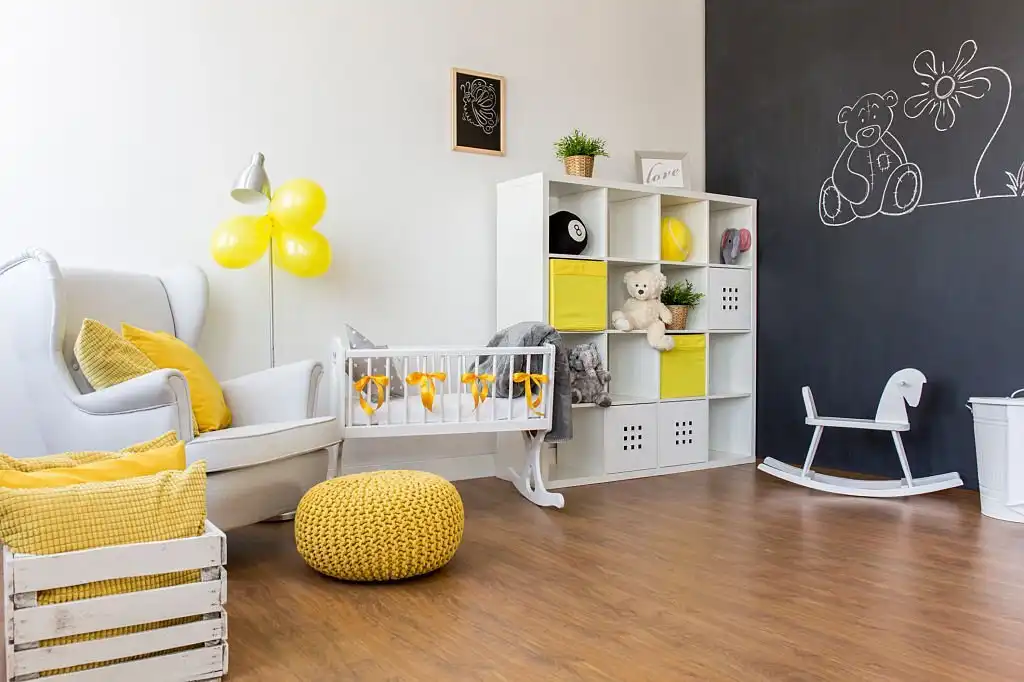The Ultimate Guide To Choosing The Perfect Nursery Room

It’s exciting to be expecting a child. One of the most crucial considerations while planning is where the baby will dwell in your house.
The nursery should be selected based on the available rooms in the house and which room is the safest and nearest to the parents.
It might be utilized for two purposes to make the most of the available space. There are several ways to make space for a newborn without a dedicated nursery for parents with only one bedroom.
Keep reading for a thorough list of questions before selecting your baby’s nursery space.
How to choose the right nursery room

Numerous aspects must be taken into account while selecting a kid room. The size of your house is the main deciding element. In the following section, we’ll talk about the benefits of different housing sizes.
For the majority of people, choosing the ideal room for your child will include responding to five fundamental questions:
- – What rooms are unoccupied?
- What is the most advantageous location?
- Which room is the most secure?
- Which room can serve more than one purpose?
- Can more than one person occupy a bedroom?
Availability
Consider which rooms may be converted into a nursery first. A customized nursery can be easily created out of space.
Pick a nursery space that is relatively close to the parent’s bedroom. Consider moving or rearranging the extra bedrooms if none of those options are accessible.
Location
The nursery’s location is a preference.
For convenience and late-night feedings, some parents like the baby’s nursery to be adjacent to their bedroom, while others prefer the nursery to be as far away as possible. This idea ensures that no one else is disturbed by the late-night activity.
Pick a space that doesn’t receive much direct sunlight. If it happens, move the furniture around, so the crib isn’t directly in the sun. This will contribute to the baby’s comfort. Additionally, it will shield the baby’s eyes from the sun.
Safety
It’s crucial to pick the safest area in the house. Location, proximity to the parents, and conventional safety practices are some considerations while selecting the safest room.
Pick a room that doesn’t have a draught. Equally crucial is ensuring that the future nursery room doesn’t become overheated. Young neonates require a space with a constant temperature since they cannot regulate their body temperature.
Pick a nursery space that is close to the parent’s bedroom. It will be more challenging to access the nursery in case of an emergency if it is located on a different level. In a crisis, proximity will be essential.
A smoke detector and a CO detector should be installed in every room to help you recognize problems.
Keep windows and cables away from the crib. Baby safety hazards include cords and drapes.
Dual purpose
It is possible to use the nursery for a secondary function. A nursery might be combined with a guest room or an office.
Always consider lowering the secondary objective after attending to the needs of the nursery. Choose smaller and more compact furnishings to ensure that the area still fulfills its purpose without seeming crowded. A dual-purpose room can be quickly converted with the help of a murphy bed or fold-away desk.
Consider inventive storage solutions. To add more storage without taking up too much space, find organizers.
To begin with, a baby doesn’t require many things. The only thing that is required is a crib with a diaper-changing area. The baby and visitors can use a dresser. During their stay, leave a few drawers accessible for your visitors to use.
Co-habitation
Any size of residence can accommodate sharing a bedroom. Sharing a bedroom is cost-effective and, most of the time, advantageous.
Consider making a room that already inhabited the nursery. Instead of having to move the youngest child’s bedroom altogether, consider adding a nursery.
It is convenient to have rapid access to a baby if they share a parent’s bedroom. The baby and the items a baby will need can have their area in the parent’s room.
Choosing the nursery in a large home with extra bedrooms
The benefits of living in a big house are numerous. The additional bedrooms make it simple to designate additional rooms for a specific use, like a nursery.
Avoid putting the nursery on a different floor from the parent’s bedroom in a big house. If there is a crisis, it will take too long to get to the baby. To do this, you might occasionally need to swap bedrooms.
Consider moving rooms around to make the desired space for the nursery if the best alternative has been chosen. Although the process may take longer, the outcome will be worthwhile.
Choosing the nursery room in a smaller house with full bedrooms
Maybe every bedroom is occupied, but you’d still prefer a nursery to have its own space.
How will you make a place for a new baby in a house that’s already crowded?
- What rooms can be condensed?
- What room can I do away with?
- Can I rearrange the bedrooms?
Let’s examine the first query. Any rooms that can be combined are there?
If your home is crowded, consider shifting older kids into shared rooms rather than giving them each their own space. Do you have an office and a craft room? The two may be combined into one space, freeing up a bedroom. Similar to how a guest room and office can be merged to create a nursery room.
The expecting parents can put the nursery in the same room as another kid. This would offer solace and a chance for sibling connection.
The second query explores the idea of having too much.
Is there anything you could eliminate in a crowded home to make room for a bedroom? Can you put those items in the garage or sell them at a yard sale? If you have a personal gym, consider how to relocate it to the basement.
Space is made available for a nursery by choosing one of these solutions or a combination of them all.
Although rearranging bedrooms is a complex undertaking, it may be done successfully. The best option would be to rearrange and move rooms if the bedroom you want for the nursery is already occupied.
Creating a nursery in a one-bedroom house
Even a one-bedroom house can be converted into a nursery. For these tiny homes, there are a few possibilities. A nursery does not need to be vast to be helpful.
Parents can designate a portion of their bedroom as a nursery in a one-bedroom home. A communal area is comfortable. Sharing a bedroom reduces the number of extra trips made to the baby’s room. Additionally, having a shared bedroom keeps the infant close by.
Consider making a place for the nursery in the bedroom’s walk-in closet if one exists. The majority of walk-in closets have space for a crib. Place the baby’s items in a hanging closet organizer next to the crib for ease. The old closet is instantly transformed into a new nursery.
Undoubtedly, the nursery is a crucial aspect of bringing a baby. The nursery should be placed in a safe and convenient location for parents to get to and where there is additional room to accommodate the baby and the items they will need. Any home can have room for a nursery, regardless of its size.
Also Read: Bedroom Nursery Tips: How to Create baby Nursery in Your Bedroom
Verdict on which bedroom should be the nursery
After considering the three factors mentioned in the title, it is clear that the best room for the nursery is the small bedroom.
This is because large bedrooms can be too overwhelming for a child, while one-bedroom homes do not have the space to spare.
Small bedrooms are the perfect size for a nursery, and they can be easily converted back to a guest room when the time comes.
FAQs on which bedroom should be the nursery
Which room in the house should be the nursery?
The majority of nurseries and children’s rooms are somewhat compact. They are, at most, the size of a second or third bedroom and frequently even less.
The “nursery” in an apartment may be a sizable closet with the door removed or a portion of the parent’s bedroom. As a result, thoughtful space planning is always necessary.
How long should you room share with a baby?
To lower the risk of sudden infant death syndrome, the AAP advises sharing a room with parents but not a bed, “preferably for a year, but at least for six months” (SIDS).
Can a baby cot go under a window?
Babies are less able to regulate their body temperature. Thus the cot shouldn’t be located close to a radiator or a window in the sun. Blind cords pose a risk because they have been known to entangle and choke infants.
